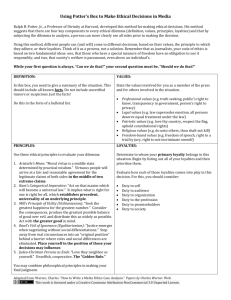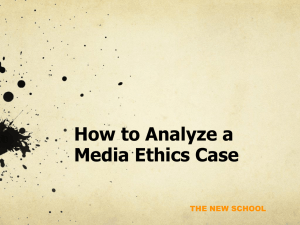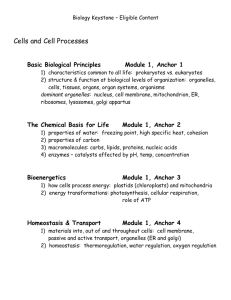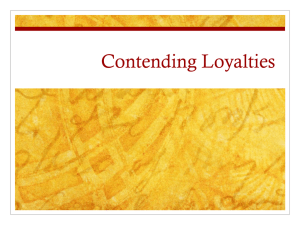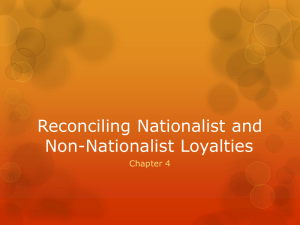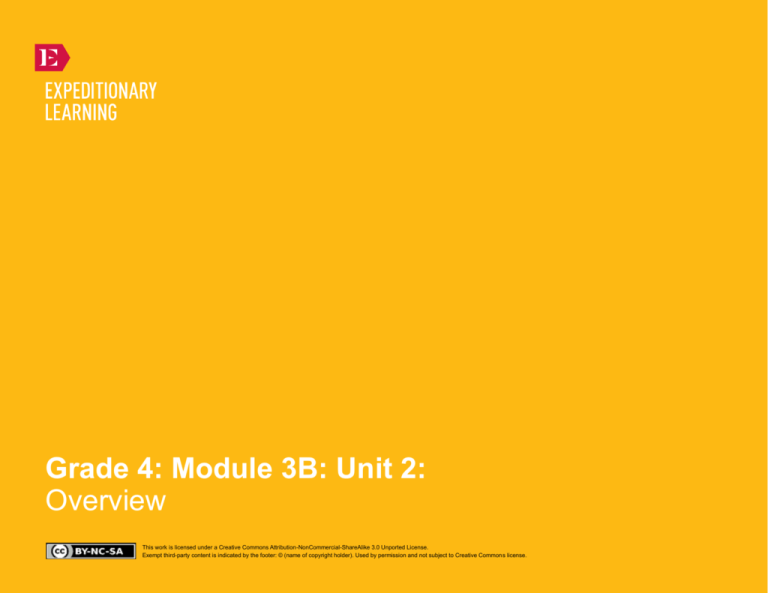
Grade 4: Module 3B: Unit 2:
Overview
This work is licensed under a Creative Commons Attribution-NonCommercial-ShareAlike 3.0 Unported License.
Exempt third-party content is indicated by the footer: © (name of copyright holder). Used by permission and not subject to Creative Commons license.
GRADE 4: MODULE 3B: UNIT 2: OVERVIEW
Perspectives on the American Revolution:
Digging Deeper into Perspectives through Literature
Unit 2: Digging Deeper into Perspectives through Literature
In this unit, students read the play Divided Loyalties, by Gare Thompson, to dig
deeper into the perspectives of Patriots and Loyalists. Students read about the
Barton family and analyze how various members of the family react to the events of
the looming American Revolution. Throughout the unit, they practice reading aloud
to build fluency skills. At key points in the play, students pause to do a close read of
select lines from the Declaration of Independence and analyze these lines to
determine their meaning.
Afterward, students are given a discussion prompt that asks them to infer how
specific characters in the play would react to these lines from the Declaration.
Students then gather evidence from Divided Loyalties and engage in a class
discussion based on this prompt. This analysis of both the perspectives in the play
and the Declaration helps to prepare students for Unit 3, when they will be asked to
write their own opinions about the Revolutionary War.
Guiding Questions and Big Ideas
• How does a person’s perspective influence her or his opinion?
• Why should we respect the opinions of others?
• American colonists had different perspectives on fighting for independence from Great Britain.
• Characters’ perspectives can be inferred by what they say and do in a story.
Copyright © 2013 by Expeditionary Learning, New York, NY. All Rights Reserved
NYS Common Core ELA Curriculum • G4:M3B:U2: Overview • June 2014 •
1
GRADE 4: MODULE 3B: UNIT 2: OVERVIEW
Perspectives on the American Revolution:
Digging Deeper into Perspectives through Literature
Mid-Unit 2 Assessment
Reading and Answering Questions about Divided Loyalties
This assessment centers on NYSP12 ELA CCLS RL.4.1, RL.4.5, L.4.4a, and L.4.4c. Students read a new scene from Divided
Loyalties. They answer multiple-choice and selected response text-dependent questions that include comprehension of key
passages and vocabulary. They also identify the parts of a drama.
End of Unit 2 Assessment
Part 1: Conducting a Literary Discussion and Part 2 and 3: Analyzing, Summarizing and Reading Aloud
Divided Loyalties
This three-part assessment centers on NYSP12 ELA CCLS RL.4.2, RL.4.3, RF.4.4, and SL.4.1 and takes place during Lessons 9
and 10. In the first part of the assessment, students prepare for and discuss the following question: Read the following line
from the Declaration of Independence: “We, therefore, … solemnly publish and declare, That these United Colonies are, and of
Right ought to be Free and Independent States.” In your opinion, what would the characters in Divided Loyalties think of this
line? Would they agree with the ideas in this excerpt? Why or why not? During their discussion, students must use evidence
from the text to support their answers. Then in Parts 2 and 3 students answer questions to analyze a scene from the play.
They then summarize this scene and read it aloud to demonstrate their fluency.
Copyright © 2013 by Expeditionary Learning, New York, NY. All Rights Reserved
NYS Common Core ELA Curriculum • G4:M3B:U2: Overview • June 2014 •
2
GRADE 4: MODULE 3B: UNIT 2: OVERVIEW
Perspectives on the American Revolution:
Digging Deeper into Perspectives through Literature
Content Connections
This module is designed to address English Language Arts standards. However, the module intentionally incorporates Social Studies and Science content that many
teachers may be teaching during other parts of the day. These intentional connections are described below.
Big ideas and guiding questions are informed by the New York State Common Core K–8 Social Studies Framework:
NYS Social Studies Core Curriculum:
• Standard 1—Students will use a variety of intellectual skills to demonstrate their understanding of major ideas, eras, themes, developments, and turning points in the
history of the United States and New York.
Texts
1. Gare Thompson, Divided Loyalties: The Barton Family during the American Revolution (Monterey, CA: National Geographic School Publishing, 2006), ISBN: 9780792258674. (L600–800)
Copyright © 2013 by Expeditionary Learning, New York, NY. All Rights Reserved
NYS Common Core ELA Curriculum • G4:M3B:U2: Overview • June 2014 •
3
GRADE 4: MODULE 3B: UNIT 2: OVERVIEW
Unit-at-a-Glance
This unit is approximately 2 weeks or 10 sessions of instruction.
Lesson
Lesson Title
Long-Term Targets
Supporting Targets
Lesson 1
Preparing to Read Divided
Loyalties
• I can use literary terms to describe
parts of a story, poem, or drama (e.g.,
verse, rhythm, meter, casts of
characters, settings, descriptions,
dialogue, stage directions). (RL.4.5)
• I can describe the parts of a drama.
• I can identify the characteristics of
historical fiction.
Ongoing
Assessment
Anchor Charts &
Protocols
• Participation in creation of
Parts of a Drama and
Characteristics of Historical
Fiction anchor charts
• Guiding Questions anchor
chart
• Things We Notice and
Wonder about Divided
Loyalties anchor chart
• Parts of a Drama anchor
chart
• Characteristics of Historical
Fiction anchor chart
Lesson 2
Summarizing Literature and
Making Inferences: Divided
Loyalties, Act 1, Scenes 1 and 2
• I can make inferences using specific
details from text. (RL.4.1)
• I can summarize Act I, Scenes 1 and 2 of
Divided Loyalties.
• Act I, Scenes 1 and 2:
Summary
• Somebody In Wanted But
So Then anchor chart
• I can summarize a story, drama, or
poem. (RL.4.2)
• I can make inferences about characters
in Divided Loyalties using evidence
from the text.
• Act I, Scenes 1 and 2
Character Analysis notecatcher
• Reading with Fluency
anchor chart
• I can read aloud Divided Loyalties with
purpose and accuracy.
• Act I, Scenes 1 and 2
Fluency Notes
• I can read fourth-grade-level texts with
purpose. (RF.4.4a)
• I can read fourth-grade-level texts with
fluency. (RF.4.4b)
• Parts of a Drama anchor
chart
• Be a Patriot anchor chart
• Be a Loyalist anchor chart
• Back-to-Back, Face-to-Face
protocol
Copyright © 2013 by Expeditionary Learning, New York, NY. All Rights Reserved
NYS Common Core ELA Curriculum • G4:M3B:U2: Overview • June 2014 •
4
GRADE 4: MODULE 3B: UNIT 2: OVERVIEW
Unit-at-a-Glance
Lesson
Lesson Title
Long-Term Targets
Supporting Targets
Lesson 3
Introduction to Discussing a
Literary Text: : Divided
Loyalties, Act 1, Scenes 1 – 3
• I can make inferences using specific
details from text. (RL.4.1)
• I can find the meanings of unfamiliar
words to help me better understand an
excerpt from the Declaration of
Independence.
• I can prepare myself to participate in
discussions. (SL.4.1a)
• I can draw on information to explore
ideas in the discussion. (SL.4.1a)
• I can use context to help me to
determine what a word or phrase
means. (L.4.4a)
• I can use resource materials
(glossaries, dictionaries, thesauruses)
to help me determine the
pronunciation and meaning of key
words and phrases. (L.4.4c)
Lesson 4
Discussing a Literary Text and a
Closer Look at Words: Divided
Loyalties, Act 1, Scenes 1 – 3
• I can make inferences using specific
details from text. (RL.4.1)
• I can effectively engage in discussions
with diverse partners about fourthgrade topics and texts. (SL.4.1)
• I can make inferences about the
Declaration of Independence using
evidence from the text.
• I can make inferences about characters
in Divided Loyalties using evidence
from the text.
Ongoing
Assessment
Anchor Charts &
Protocols
• Act I, Scenes 3: summary
notes and written summary
(from homework)
• Declaration of
Independence anchor chart
• Declaration of
Independence Close
Reading note-catcher:
Lesson 3
• Literary Discussion Norms
anchor chart
• Close Readers Do These
Things anchor chart
• Preparing for a Literary
Discussion note-catcher
• I can prepare for a discussion about
Divided Loyalties by using evidence
from the text.
• I can effectively participate in a literary
discussion about Divided Loyalties.
• I can make inferences about characters
in Divided Loyalties using evidence
from the text.
• Preparing for a Literary
Discussion note-catcher
(from homework)
• I can effectively participate in a
discussion about Divided Loyalties.
• Participation in literary
discussion
• I can use context to help me to
determine what a word or phrase
means. (L.4.4a)
– I can prepare for the discussion by
using evidence from Divided
Loyalties.
• I can use resource materials
(glossaries, dictionaries, thesauruses)
to help me determine the
pronunciation and meaning of key
words and phrases. (L.4.4c)
– I can ask questions so I am clear
about what is being discussed.
• American Revolution
Vocabulary notebook
• Participating in a Literary
Discussion anchor chart
• Literary Discussion Norms
anchor chart
• Vocabulary Strategies
anchor chart
– I can ask questions on the topic being
discussed.
– I can follow our class norms when I
participate in a conversation.
• I can find the meanings of unfamiliar
words to help me better understand
Divided Loyalties.
Copyright © 2013 by Expeditionary Learning, New York, NY. All Rights Reserved
NYS Common Core ELA Curriculum • G4:M3B:U2: Overview • June 2014 •
5
GRADE 4: MODULE 3B: UNIT 2: OVERVIEW
Unit-at-a-Glance
Ongoing
Assessment
Anchor Charts &
Protocols
• I can make inferences about characters
in Divided Loyalties using evidence
from the text.
• Mid-Unit 2 Assessment
• Reading with Fluency
anchor chart
• I can describe the parts of a drama.
• Tracking My Progress, MidUnit 2 recording form
Lesson
Lesson Title
Long-Term Targets
Supporting Targets
Lesson 5
Mid-Unit Assessment: Reading
and Answering Questions about
Divided Loyalties
• I can explain what a text says using
specific details from the text. (RL.4.1)
• I can make inferences using specific
details from text. (RL.4.1)
• I can use literary terms to describe
parts of a story, poem, or drama (e.g.,
verse, rhythm, meter, casts of
characters, settings, descriptions,
dialogue, stage directions). (RL.4.5)
• I can compare and contrast different
narrators’ points of view. (RL.4.6)
• I can use context to help me to
determine what a word or phrase
means. (L.4.4a)
• I can explain the difference between
first-person and third-person point of
view.
• Act II, Scene 1 Fluency
Notes
• I can find the meanings of unfamiliar
words to help me better understand
Divided Loyalties.
• I can read aloud Divided Loyalties with
purpose and accuracy.
• I can use resource materials
(glossaries, dictionaries, thesauruses)
to help me determine the
pronunciation and meaning of key
words and phrases. (L.4.4c)
Copyright © 2013 by Expeditionary Learning, New York, NY. All Rights Reserved
NYS Common Core ELA Curriculum • G4:M3B:U2: Overview • June 2014 •
6
GRADE 4: MODULE 3B: UNIT 2: OVERVIEW
Unit-at-a-Glance
Lesson
Lesson Title
Long-Term Targets
Supporting Targets
Ongoing
Assessment
Anchor Charts &
Protocols
Lesson 6
Discussing a Literary Text:
Divided Loyalties Act II, Scenes
2 and 3
• I can make inferences using specific
details from text. (RL.4.1)
• I can make inferences about the
Declaration of Independence using
evidence from the text.
• Act II, Scenes 2 and 3:
summary notes and written
summary (from homework)
• Declaration of
Independence anchor chart
• I can make inferences about characters
in Divided Loyalties using evidence
from the text.
• Declaration of
Independence Close
Reading note-catcher:
Lesson 6
• I can describe a story's character,
setting, or events using specific details
from the text. (RL.4.3)
• I can effectively engage in discussions
with diverse partners about fourthgrade topics and texts. (SL.4.1)
• I can effectively participate in a
discussion about Divided Loyalties.
– I can prepare for the discussion by
using evidence from Divided
Loyalties.
• Preparing for a Literary
Discussion note-catcher
• Participating in a literary
discussion
• Literary Discussion Norms
anchor chart
• Participating in a Literary
Discussion anchor chart
• Be a Patriot anchor chart
• Be a Loyalist anchor chart
• Close Readers Do These
Things anchor chart
– I can ask questions so I am clear
about what is being discussed.
– I can ask questions on the topic being
discussed.
• I can follow our class norms when I
participate in a conversation.
Lesson 7
A Closer Look at Words and
Reading Aloud with Accuracy:
Divided Loyalties Act II, Scenes
2 and 3
• I can use clues in the text to check my
accuracy. (RF.4.4c)
• I can reread to make sure that what
I’m reading makes sense. (RF.4.4c)
• I can use context to help me to
determine what a word or phrase
means. (L.4.4a)
• I can find the meanings of unfamiliar
words to help me better understand
Divided Loyalties.
• American Revolution
Vocabulary notebook (from
Unit 1)
• I can read aloud Divided Loyalties with
accuracy, using clues in the text to check
my accuracy and rereading to make sure
what I'm reading makes sense.
• Act III, Scene 1 Fluency
Notes
• Vocabulary Strategies
anchor chart
• Reading with Fluency
anchor chart
• Concentric Circles protocol
• I can use resource materials
(glossaries, dictionaries, thesauruses)
to help me determine the
pronunciation and meaning of key
words and phrases. (L.4.4c)
Copyright © 2013 by Expeditionary Learning, New York, NY. All Rights Reserved
NYS Common Core ELA Curriculum • G4:M3B:U2: Overview • June 2014 •
7
GRADE 4: MODULE 3B: UNIT 2: OVERVIEW
Unit-at-a-Glance
Lesson
Lesson Title
Long-Term Targets
Supporting Targets
Lesson 8
Summarizing a Literary Text:
Divided Loyalties Act 1, Scene 1
through Act III , Scene 1
• I can summarize a story, drama, or
poem. (RL.4.2)
• I can determine the main idea of each
scene I've read in Divided Loyalties.
• I can summarize the events of Act I,
Scene 1 through Act III, Scene 1 of
Divided Loyalties.
Ongoing
Assessment
Anchor Charts &
Protocols
• Act III, Scene 1: summary
notes and summary (from
homework)
• Act I, Scene 1–Act III, Scene
1: Story Map
• Act I, Scene 1–Act III, Scene
1: Summary
Lesson 9
End of Unit Assessment, Part 1:
Conducting a Literary
Discussion
• I can make inferences using specific
details from text. (RL.4.1)
• I can describe a story's character,
setting, or events using specific details
from the text. (RL.4.3)
• I can effectively engage in discussions
with diverse partners about fourthgrade topics and texts. (SL.4.1)
• I can make inferences about the
Declaration of Independence using
evidence from the text.
• Act III, Scenes 2 and 3:
summary notes and
summary (from homework)
• I can make inferences about characters
in Divided Loyalties using evidence
from the text.
• Declaration of
Independence Close
Reading note-catcher:
Lesson 9
• I can effectively participate in a
discussion about Divided Loyalties.
• I can use context to help me to
determine what a word or phrase
means. (L.4.4a)
– I can prepare for the discussion by
using evidence from Divided
Loyalties.
• I can use resource materials
(glossaries, dictionaries, thesauruses)
to help me determine the
pronunciation and meaning of key
words and phrases. (L.4.4c)
– I can ask questions so I am clear
about what is being discussed.
Copyright © 2013 by Expeditionary Learning, New York, NY. All Rights Reserved
• End of Unit 2 Assessment,
Part I: Conducting a
Literary Discussion
• Declaration of
Independence anchor chart
• Participating in a Literary
Discussion anchor chart
• Literary Discussion Norms
anchor chart
• Close Readers Do These
Things anchor chart
– I can ask questions on the topic being
discussed.
• I can follow our class norms when I
participate in a conversation.
NYS Common Core ELA Curriculum • G4:M3B:U2: Overview • June 2014 •
8
GRADE 4: MODULE 3B: UNIT 2: OVERVIEW
Unit-at-a-Glance
Lesson
Lesson Title
Long-Term Targets
Supporting Targets
Lesson 10
End of Unit Assessment, Parts 2
and 3: Analyzing, Summarizing,
and Reading Aloud Divided
Loyalties
• I can summarize a story, drama, or
poem. (RL.4.2)
• I can summarize Divided Loyalties.
• I can describe a story's character,
setting, or events using specific details
from the text. (RL.4.3)
• I can read fourth-grade-level texts
accurately and fluently to make
meaning. (RF.4.4)
a. I can read fourth-grade-level
texts with purpose.
• I can make inferences about characters
and events in Divided Loyalties using
evidence from the text.
Ongoing
Assessment
Anchor Charts &
Protocols
• End of Unit 2 Assessment,
Parts 2 and 3: Analyzing,
Summarizing, and Reading
Aloud Divided Loyalties
• I can read aloud Divided Loyalties with
purpose, understanding, and accuracy,
using clues in the text to check my
accuracy and rereading to make sure
what I'm reading makes sense.
b. I can read fourth-grade-level
texts with fluency.
c. I can use clues in the text to
check my accuracy.
c. I can reread to make sure that
what I’m reading makes sense.
Copyright © 2013 by Expeditionary Learning, New York, NY. All Rights Reserved
NYS Common Core ELA Curriculum • G4:M3B:U2: Overview • June 2014 •
9
GRADE 4: MODULE 3B: UNIT 2: OVERVIEW
Unit-at-a-Glance
Optional: Experts, Fieldwork, and Service
Experts:
• Invite a local theater teacher to come in and work with students on expression to help them improve their fluency.
Fieldwork:
• Arrange for students to see a play or a Readers Theater performed.
Optional: Extensions
• Organize students to practice and preform Divided Loyalties for an audience within or outside the school setting.
• Teach students to write a Readers Theater of their own based on their reading about the Battle of Lexington and Concord in Unit 1.
Copyright © 2013 by Expeditionary Learning, New York, NY. All Rights Reserved
NYS Common Core ELA Curriculum • G4:M3B:U2: Overview • June 2014 •
10
GRADE 4: MODULE 3B: UNIT 2: OVERVIEW
Preparation and Materials
Preparation and Materials
Students should continue to work toward mastery of fluent reading skills outlined in the Foundational Reading and Language Skills Resource Package. To help
students increase accuracy and move on to establishing goals aligned to more complex criteria described in the Fluency Self-Assessment, such as punctuation, phrasing
and expression, consider having students reread pages of Divided Loyalties. See also the Fluency Resource (in the Foundational Reading and Language Skills
Resource Package, which is a stand-alone document on EngageNY.org).
Copyright © 2013 by Expeditionary Learning, New York, NY. All Rights Reserved
NYS Common Core ELA Curriculum • G4:M3B:U2: Overview • June 2014 •
11

